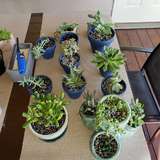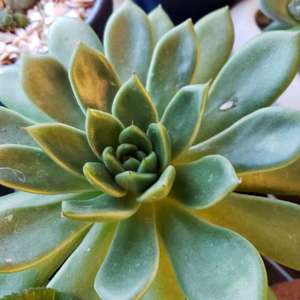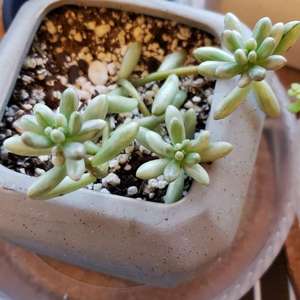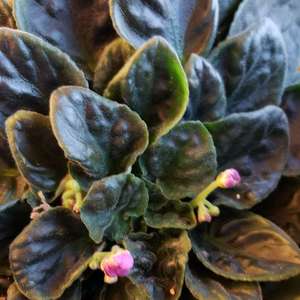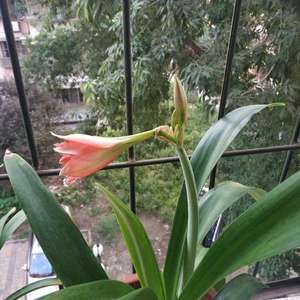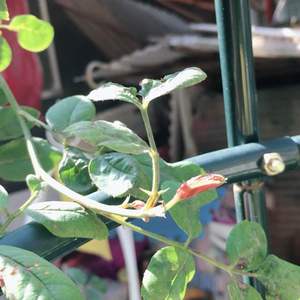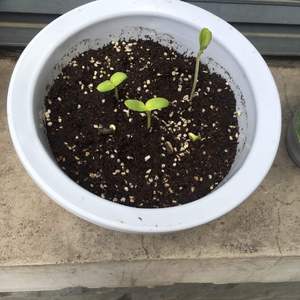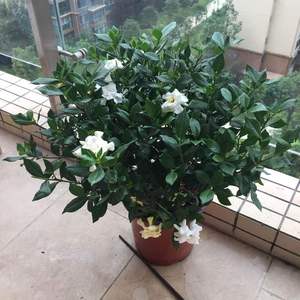文章
Miss Chen
2018年08月22日

Plumbago can be rooted from stem or root cuttings. Unless you will be rooting them indoors, make the cuttings in fall or spring so the rootings benefit from mild temperatures while they become established.

Stem Cuttings
Cuttings should be 3 to 4 inches long, taken just below a leaf node, recommends Andromeda Botanic Gardens. Strip the leaves from the bottom half of the plumbago cutting. Dip the stripped half in water, then in rooting hormone, if available. Use a pencil to make a depression in the soil where you will plant your cutting. Place the cutting and firm the soil around it.
Root Cuttings
The University of Florida recommends root cuttings for propagating plumbago. Take cuttings from the mature root (1/4- to 1/2-inch diameter) of a two- to three-year-old plumbago in late winter or early spring, says the University of Florida IFAS Extension. Bury 2- to 6-inch-long cuttings horizontally under 1/2 inch of rooting medium.

Considerations
Keep plumbago cuttings out of direct sunlight but in a bright place until they've rooted. Keep the soil evenly moist. Covering the cuttings with a clear plastic covering helps conserve moisture and prevents wind damage.

Stem Cuttings
Cuttings should be 3 to 4 inches long, taken just below a leaf node, recommends Andromeda Botanic Gardens. Strip the leaves from the bottom half of the plumbago cutting. Dip the stripped half in water, then in rooting hormone, if available. Use a pencil to make a depression in the soil where you will plant your cutting. Place the cutting and firm the soil around it.
Root Cuttings
The University of Florida recommends root cuttings for propagating plumbago. Take cuttings from the mature root (1/4- to 1/2-inch diameter) of a two- to three-year-old plumbago in late winter or early spring, says the University of Florida IFAS Extension. Bury 2- to 6-inch-long cuttings horizontally under 1/2 inch of rooting medium.

Considerations
Keep plumbago cuttings out of direct sunlight but in a bright place until they've rooted. Keep the soil evenly moist. Covering the cuttings with a clear plastic covering helps conserve moisture and prevents wind damage.
0
0
文章
Miss Chen
2018年08月18日

Boston ferns (Nephrolepis exaltata), sometimes called sword ferns, have bright green fronds that grow up to 3 feet long and 6 inches wide. The fronds have serrated edges and a rough texture. They are shade-lovers and grow best in soil that is very rich and lightly moist. Boston ferns are hardy in U.S. Department of Agriculture zones 8B through 11 and can be planted outdoors during any season. Frost will kill the foliage during winter, but new fronds emerge from the center of the plant once temperatures warm in spring.

Step 1
Use a garden fork to loosen the soil 10 to 12 inches deep. Amend with 2 to 3 inches of organic compost.
Step 2
Dig a hole the same depth and 2 to 3 inches wider than the fern's root system. Place the roots into the soil at the same level they were growing before. Backfill with the loosened soil and water until it is well-moistened, but not soggy.
Step 3
Check the soil regularly and water whenever the top inch is dry.
Step 4
Feed once each month, from spring until fall, with houseplant fertilizer.
Step 5
Clip off damaged fronds as necessary.

Step 6
Divide every two to three years in early spring.
Step 1
Use a garden fork to loosen the soil 10 to 12 inches deep. Amend with 2 to 3 inches of organic compost.
Step 2
Dig a hole the same depth and 2 to 3 inches wider than the fern's root system. Place the roots into the soil at the same level they were growing before. Backfill with the loosened soil and water until it is well-moistened, but not soggy.
Step 3
Check the soil regularly and water whenever the top inch is dry.
Step 4
Feed once each month, from spring until fall, with houseplant fertilizer.
Step 5
Clip off damaged fronds as necessary.

Step 6
Divide every two to three years in early spring.
0
0
文章
Miss Chen
2018年08月15日

When to prune sedum (Sedum spp.) is a question that is not answered with just a simple date. Pruning the flowering perennial, which grows in U.S. Department of Agriculture plant hardiness zones 3 through 10, depends on the size of the plant, the variety and how you want it to look. A compact, low-growing sedum requires different maintenance pruning than a tall, late-blooming variety.

Before You Prune
Before you prune your sedum, disinfect your pruning tools. Pruning shears are best for cutting back tall plants, while snips work well for pinching or clipping leaves. After brushing any dirt from the tool blades, disinfect the blades by soaking them for at least five minutes in a household disinfectant. After removing the tool from the disinfectant, rinse the blades with clean water and let them dry before using them on your plants. Repeat the disinfecting process before pruning another plant to avoid spreading disease.
Pinching for Shape
To encourage branching and low growth on young plants, pinching is recommended. To pinch the plant, use your fingers or pruning snips to remove the center growth from the top of a stem. Take care not to damage the buds or small leaf sets on either side of the center growth; these buds are where the branching will occur. Pinch back new plants when they are about 8 inches tall. You can still pinch off up to 2 inches after blooms start to appear, but it will delay flowering. The result is sedum with more horizontal growth, less vertical growth and added fullness.
Late Spring Pruning
A more severe pruning is required to encourage bushiness on an older plant that has gotten top heavy or leggy. To encourage new plant growth and get a fuller plant, cut the sedum back by one-half in May or June. New flower buds will form on the cut stalks, so you won't be sacrificing any of the showy display for the sake of a neater looking plant. Choose a point about halfway down a stalk and just above a set of leaves to make your cut. Cut cleanly through the stalk with sharp pruning shears, taking care not to damage the leaf set. Repeat with each stalk until the sedum is a uniform height.
Early Spring Pruning
Some varieties of tall sedum, such as "Autumn Joy" (Sedum x "Autumn Joy"), which grows in USDA zones 5 through 9, flower through the winter and need cut back in late winter or early spring. You can cut the sedum back in winter as soon as the flowers fade or any time after that until you see green peeping from the ground in spring. Cut the entire plant back to ground level using pruning shears or break the stalks at ground level by hand. In the spring, the sedum will re-emerge from the roots.

Year-Round Pruning
Some types of pruning are necessary year-round. This includes pruning out dead plant growth and cutting out diseased plant material. Removing these from your sedum as you see them will help keep the plant looking its best, keep it healthy and less prone to fungal or insect infestations. Cut dead stalks back to the base of the stalk. Pull any dead leaves when you spot them. Remove diseased portions of the plant to keep disease from spreading. Make sure you cut back far enough that you are leaving only healthy plant material. Make the cut just above a leaf set for new growth. Do not compost diseased sedum material.

Before You Prune
Before you prune your sedum, disinfect your pruning tools. Pruning shears are best for cutting back tall plants, while snips work well for pinching or clipping leaves. After brushing any dirt from the tool blades, disinfect the blades by soaking them for at least five minutes in a household disinfectant. After removing the tool from the disinfectant, rinse the blades with clean water and let them dry before using them on your plants. Repeat the disinfecting process before pruning another plant to avoid spreading disease.
Pinching for Shape
To encourage branching and low growth on young plants, pinching is recommended. To pinch the plant, use your fingers or pruning snips to remove the center growth from the top of a stem. Take care not to damage the buds or small leaf sets on either side of the center growth; these buds are where the branching will occur. Pinch back new plants when they are about 8 inches tall. You can still pinch off up to 2 inches after blooms start to appear, but it will delay flowering. The result is sedum with more horizontal growth, less vertical growth and added fullness.
Late Spring Pruning
A more severe pruning is required to encourage bushiness on an older plant that has gotten top heavy or leggy. To encourage new plant growth and get a fuller plant, cut the sedum back by one-half in May or June. New flower buds will form on the cut stalks, so you won't be sacrificing any of the showy display for the sake of a neater looking plant. Choose a point about halfway down a stalk and just above a set of leaves to make your cut. Cut cleanly through the stalk with sharp pruning shears, taking care not to damage the leaf set. Repeat with each stalk until the sedum is a uniform height.
Early Spring Pruning
Some varieties of tall sedum, such as "Autumn Joy" (Sedum x "Autumn Joy"), which grows in USDA zones 5 through 9, flower through the winter and need cut back in late winter or early spring. You can cut the sedum back in winter as soon as the flowers fade or any time after that until you see green peeping from the ground in spring. Cut the entire plant back to ground level using pruning shears or break the stalks at ground level by hand. In the spring, the sedum will re-emerge from the roots.

Year-Round Pruning
Some types of pruning are necessary year-round. This includes pruning out dead plant growth and cutting out diseased plant material. Removing these from your sedum as you see them will help keep the plant looking its best, keep it healthy and less prone to fungal or insect infestations. Cut dead stalks back to the base of the stalk. Pull any dead leaves when you spot them. Remove diseased portions of the plant to keep disease from spreading. Make sure you cut back far enough that you are leaving only healthy plant material. Make the cut just above a leaf set for new growth. Do not compost diseased sedum material.
0
0
文章
Miss Chen
2018年08月09日

Description: This plant is a summer annual about 3-5' tall that branches dichotomously. The stems are green or purple and largely hairless, although young stems often have conspicuous hairs. The alternate leaves are up to 8" long and 6" across (excluding the petioles). They are ovate or ovate-cordate in outline, but pinnately lobed. These lobes are somewhat shallow and pointed at their tips; there are usually 2-3 of these lobes on each side of the leaf blade. The margin of each leaf may have a few secondary lobes or coarse dentate teeth, otherwise it is smooth or slightly undulate. The leaves may be slightly pubescent when young, but become hairless with age; the upper surface of each leaf is often dark green and dull. The foliage of Jimsonweed exudes a bitter rank odor.
Individual flowers occur where the stems branch dichotomously; the upper stems also terminate in individual flowers. The funnelform corolla of each flower is up to 5" long and 2" across when fully open; its outer rim has 5 shallow lobes. Each of these lobes forms an acute point in the middle.The corolla is white or pale violet throughout, except at the throat of the flower, where thick veins of dark violet occur. The light green calyx is shorter than the corolla and conspicuously divided along its length by 5 membranous wings. The blooming period occurs from mid-summer to early fall and lasts about 2 months. The flowers usually don't open up until midnight and close early in the morning; less often, the flowers may bloom toward the middle of the day, especially when it is cloudy. Individual flowers last only a single day. Each flower is replaced by a hard fruit that is dry and spiny; it is about 1½" long, 1" across, and spheroid-ovoid in shape. Underneath each fruit is a truncated remnant of the calyx that curves sharply downward. These fruits are initially green, but become brown with maturity; they divide into 4 segments to release the seeds. The large seeds are dull, irregular, and dark-colored; their surface may be pitted or slightly reticulated. The root system consists of taproot that is shallow for the size of the plant; it branches frequently. Jimsonweed spreads by reseeding itself.

Cultivation: The preference is full or partial sun, moist to mesic conditions, and a rich fertile soil with high nitrogen content. This type of soil is necessary to supply the nutrients that are required by the prodigious growth of this annual plant. The foliage is often pitted by tiny holes that are made by flea beetles (the same or similar species that attack eggplant). The seeds can remain viable in the ground for several years.
Range & Habitat: Jimsonweed is a fairly common plant that has been observed in most counties of Illinois (see Distribution Map). It is probably adventive from tropical America and it was first observed in the United States at the Jamestown colony during the 17th century. Typical habitats include cropland (particularly corn fields), fallow fields, old feed lots, piles of soil at construction sites, mounds of decomposed mulch and discarded vegetation, urban vacant lots, and miscellaneous waste areas. Disturbed areas with open fertile soil are strongly preferred.

Faunal Associations: The flowers are cross-pollinated by nectar-seeking Sphinx moths. Various species of beetles are attracted by the flowers, especially at night, where they steal nectar and chomp on the pollen. The foliage and other parts of Jimsonweed are a source of food for several flea beetles (Epitrix spp.), Three-lined Potato Beetle (Lema daturaphila), Colorado Potato Beetle (Leptinotarsa decemlineata), Clavate Tortoise Beetle (Plagiometriona clavata), and larvae of the Pink-spotted Hawk Moth (Agrius cingulata); see Clark et al. (2004) and Covell (1984/2005). The foliage and seeds contain an impressive assortment of toxic alkaloids that can be fatal to mammalian herbivores and humans. Some of these alkaloids are mildly narcotic and hallucinogenic. The immature seeds are especially poisonous; as few as 20 seeds can fatally poison a child. It is doubtful that birds make any use of these toxic seeds. Humans help to spread the seeds around through activities that are related to agriculture, construction, and landscaping.

Photographic Location: Near piles of soil at a vacant lot in Champaign, Illinois. These piles of soil were dumped and occasionally carried off by trucks in relation to off-site construction and landscaping activities.
Comments: The common name 'Jimsonweed' is probably a corruption of 'Jamestown Weed,' referring to where this species was first observed in North America. Another common name that is often used for this species is 'Thornapple.' Two varieties of Jimsonweed have been described. The typical variety has green stems and white flowers, while var. tatula has purple stems and either pale violet or purple-striped flowers. Jimsonweed has a distinct appearance, making it easy to identify.

The only other Datura spp. in Illinois, Datura wrightii (Angel's Trumpet), rarely naturalizes in the wild. It is sometimes cultivated in flower gardens because of its attractive flowers. Angel's Trumpet is a hairier plant with unlobed leaves and larger flowers. The corolla of its flowers ranges from 5-8" in length, while the corolla of Jimsonweed's flowers is about 3–5" in length. Both of these Datura spp. have flowers that bloom during the night. Another species in the Nightshade family, Nicandra physalodes (Shoofly Plant), also rarely naturalizes in the wild. The Shoofly Plant has foliage that is similar to Jimsonweed, but its funnelform flowers are much smaller (less than 1½" long and across). Unlike Jimsonweed, the flowers of Shoofly Plant are strictly diurnal.
Individual flowers occur where the stems branch dichotomously; the upper stems also terminate in individual flowers. The funnelform corolla of each flower is up to 5" long and 2" across when fully open; its outer rim has 5 shallow lobes. Each of these lobes forms an acute point in the middle.The corolla is white or pale violet throughout, except at the throat of the flower, where thick veins of dark violet occur. The light green calyx is shorter than the corolla and conspicuously divided along its length by 5 membranous wings. The blooming period occurs from mid-summer to early fall and lasts about 2 months. The flowers usually don't open up until midnight and close early in the morning; less often, the flowers may bloom toward the middle of the day, especially when it is cloudy. Individual flowers last only a single day. Each flower is replaced by a hard fruit that is dry and spiny; it is about 1½" long, 1" across, and spheroid-ovoid in shape. Underneath each fruit is a truncated remnant of the calyx that curves sharply downward. These fruits are initially green, but become brown with maturity; they divide into 4 segments to release the seeds. The large seeds are dull, irregular, and dark-colored; their surface may be pitted or slightly reticulated. The root system consists of taproot that is shallow for the size of the plant; it branches frequently. Jimsonweed spreads by reseeding itself.

Cultivation: The preference is full or partial sun, moist to mesic conditions, and a rich fertile soil with high nitrogen content. This type of soil is necessary to supply the nutrients that are required by the prodigious growth of this annual plant. The foliage is often pitted by tiny holes that are made by flea beetles (the same or similar species that attack eggplant). The seeds can remain viable in the ground for several years.
Range & Habitat: Jimsonweed is a fairly common plant that has been observed in most counties of Illinois (see Distribution Map). It is probably adventive from tropical America and it was first observed in the United States at the Jamestown colony during the 17th century. Typical habitats include cropland (particularly corn fields), fallow fields, old feed lots, piles of soil at construction sites, mounds of decomposed mulch and discarded vegetation, urban vacant lots, and miscellaneous waste areas. Disturbed areas with open fertile soil are strongly preferred.

Faunal Associations: The flowers are cross-pollinated by nectar-seeking Sphinx moths. Various species of beetles are attracted by the flowers, especially at night, where they steal nectar and chomp on the pollen. The foliage and other parts of Jimsonweed are a source of food for several flea beetles (Epitrix spp.), Three-lined Potato Beetle (Lema daturaphila), Colorado Potato Beetle (Leptinotarsa decemlineata), Clavate Tortoise Beetle (Plagiometriona clavata), and larvae of the Pink-spotted Hawk Moth (Agrius cingulata); see Clark et al. (2004) and Covell (1984/2005). The foliage and seeds contain an impressive assortment of toxic alkaloids that can be fatal to mammalian herbivores and humans. Some of these alkaloids are mildly narcotic and hallucinogenic. The immature seeds are especially poisonous; as few as 20 seeds can fatally poison a child. It is doubtful that birds make any use of these toxic seeds. Humans help to spread the seeds around through activities that are related to agriculture, construction, and landscaping.

Photographic Location: Near piles of soil at a vacant lot in Champaign, Illinois. These piles of soil were dumped and occasionally carried off by trucks in relation to off-site construction and landscaping activities.
Comments: The common name 'Jimsonweed' is probably a corruption of 'Jamestown Weed,' referring to where this species was first observed in North America. Another common name that is often used for this species is 'Thornapple.' Two varieties of Jimsonweed have been described. The typical variety has green stems and white flowers, while var. tatula has purple stems and either pale violet or purple-striped flowers. Jimsonweed has a distinct appearance, making it easy to identify.

The only other Datura spp. in Illinois, Datura wrightii (Angel's Trumpet), rarely naturalizes in the wild. It is sometimes cultivated in flower gardens because of its attractive flowers. Angel's Trumpet is a hairier plant with unlobed leaves and larger flowers. The corolla of its flowers ranges from 5-8" in length, while the corolla of Jimsonweed's flowers is about 3–5" in length. Both of these Datura spp. have flowers that bloom during the night. Another species in the Nightshade family, Nicandra physalodes (Shoofly Plant), also rarely naturalizes in the wild. The Shoofly Plant has foliage that is similar to Jimsonweed, but its funnelform flowers are much smaller (less than 1½" long and across). Unlike Jimsonweed, the flowers of Shoofly Plant are strictly diurnal.
0
0


